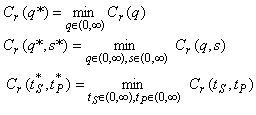|
|
Plenary Lecture
The Basic Theory and an Efficient Soft Computing for a
New Simulation Approach on several Models of Optimal
Stock Management in the Deterministic Case

Professor Nicolae Popoviciu
Hyperion University of Bucharest
Faculty of Mathematics-Informatics
Street Calarasilor 169, Bucharest, ROMANIA
E-mail:
nicolae.popoviciu@yahoo.com
Abstract:
The work is a generalization of three Wilson's models
related with the gestion (management) of stocks in the
deterministic case. A new variable r, called stock rate
or simulation rate, appears in all models. This variable
assures a better stock controlling by deterministic
simulation method. For r = 1/2 we obtain all
Wilson's results from the bibliography [4], [5]. For
each economical model the mathematical foundation is
given, together with several numerical applications and
economical interpretations. All models are based on the
same notations with their specific meanings. So we used
the following notations:
N = The total number of supplies
h = The period length (the number of days, let us
say) between two supplies; h is constant.
cL = The launch cost for one demand of
supply (the ordering cost per one order)
cH = The holding cost (in warehouse)
unit cost, per day
cP = The penalty cost per item, per
day (when the stock s is less then the client's demand)
W = The production rate of the factory, on the
unit time (the model 3)
D = The client's demand rate on the unit time
(the model 3)
From time in time the manager has to stop the production
activity, otherwise the whole quantity WT is too
big, i.e. WT >> Q.
tW = The working time (the production
time) for the factory or industrial unit
tS = The stop time (the factory
doesn't work)
tWP = The working time and the penalty
time for the factory because the client's demands are
not satisfied
tP = The penalty time and stop time
Cr(q) = The total cost (composed of
the ordering and holding cost) for interval , in model 1
Cr(q,s) = The total cost (composed of
the ordering, holding and penalty cost) for interval
[0,T], in model 2
Cr(tS,tP) = The
total cost (composed of the production cost and
ordering, holding and penalty cost) for the interval
[0,T], in model 3
In the above description the elements T, Q, W, D, cL,
cH, cP and r are
input data
The elements q, s, N, h, tS, tP,
tW, tWP are unknown data
(positive real numbers). They must be found by using the
mathematical models for the maintenance stock problem
The aim of the stock theory is to determine the best
values q* (model 1), q*, s* (model 2), tS*, tP*
(model 3) which minimize the total maintenance costs,
respectively

Each
mathematical model generates an informatics model and a
C++ program. So, the work contains three C++ valid
programs: source codification, numerical output results
and print screen. The C++ simulation programs have been
validated by supplementary techniques and independent
computations. By simulation with various values of r
a good manager has the possibility to choose the best
version of his activity.
Brief Biography of the Speaker:
Popoviciu Nicolae is PhD in mathematics (from 1976),
professor at Hyperion University of Bucharest, Romania,
Faculty of Mathematics-Informatics and the dean of this
faculty. His area of competence contains: stochastic
processes and Markov decision problems, integral
transforms (continuous, discrete, fast Fourier
transform, discrete Fourier transform), complex
functions, field theory, distribution theory, tensor
computation, mathematical programming (linear,
multi-objective, quadratic, convex, nonlinear,
stochastic, in integer numbers, Boolean) and
optimization models, artificial neural networks and
applications. He is the first author of 18 books (all in
Romanian language) and 102 papers (almost all in English
language) and more exactly the first author of 89
papers. His recently book Neural Networks. Mathematical
Foundation, Algorithms and Applications (2009, Romanian
language) is a monograph on the algorithms of neural
networks with application.
Professor Popoviciu is member of Romanian Society of
Mathematics and member of the Romanian Probability and
Statistics Society. He has participated to many WSEAS
International Conference: plenary speaker, author,
co-author, chairman, reviewer etc (Romania, Greece,
Turkey, Bulgaria, United Kingdom, USA ). |
|

